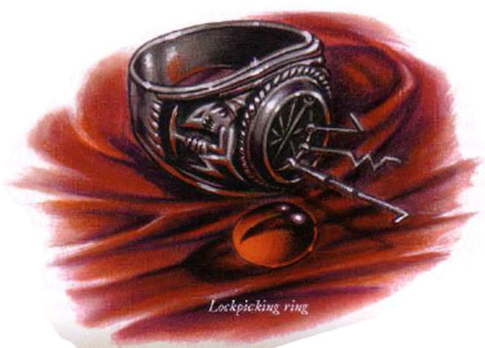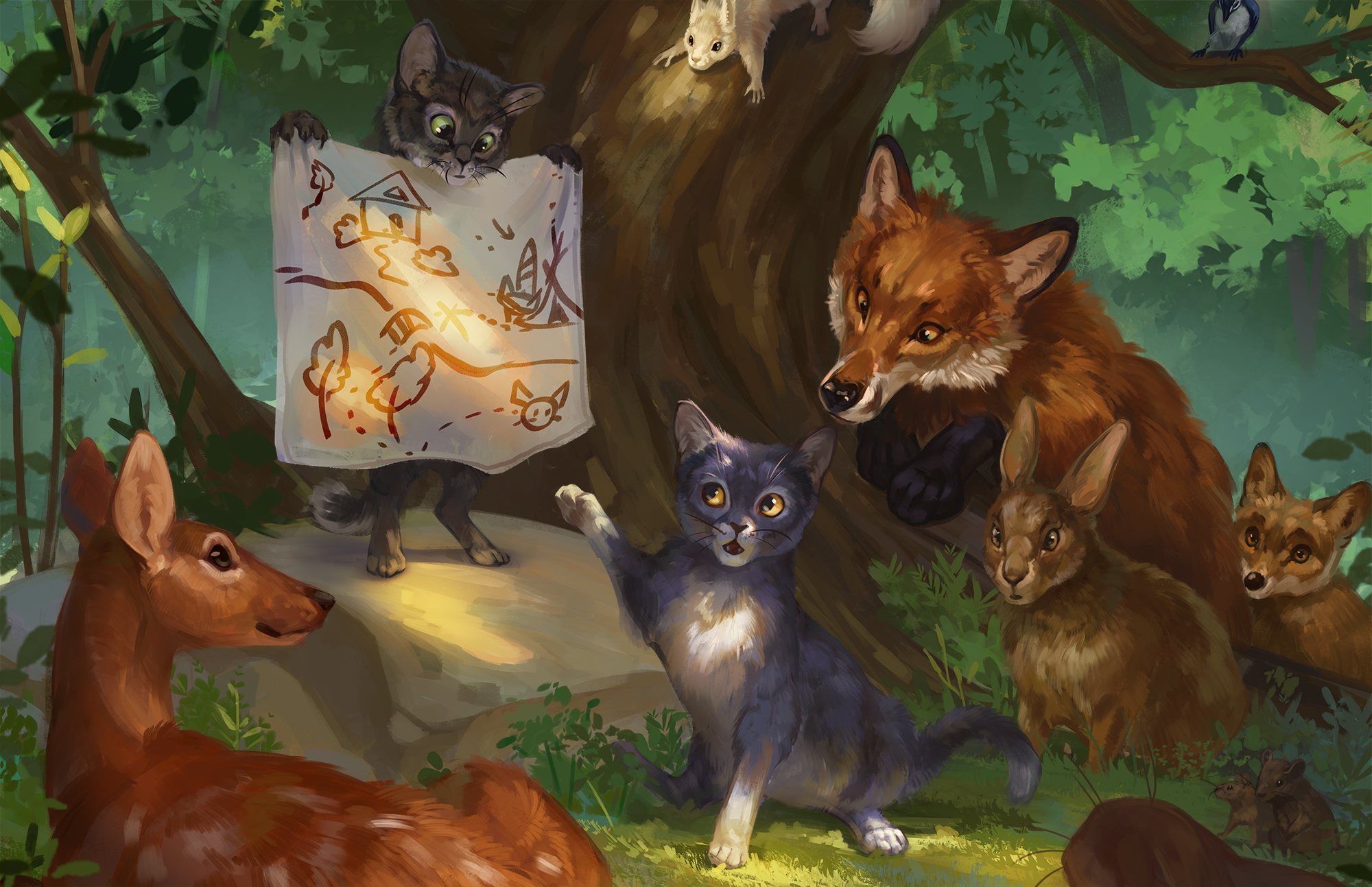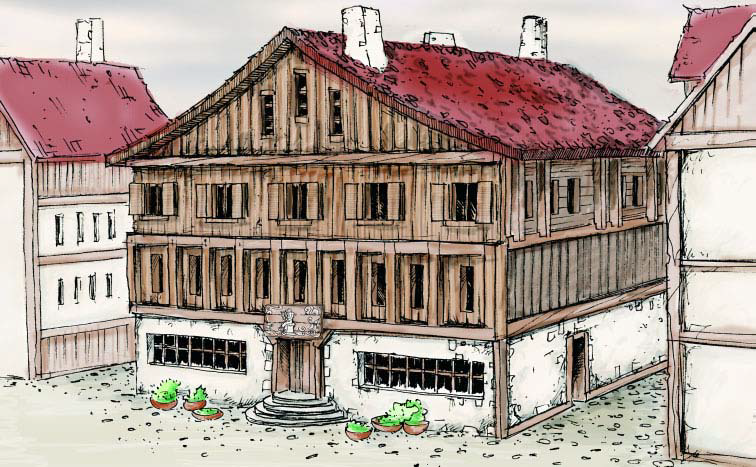
SESSION 24D: THE SECOND HOUND OF GHUL
June 21st, 2008
The 12th Day of Kadal in the 790th Year of the Seyrunian Dynasty
A few minutes later, the dog was following Agnarr and the others down the hall towards the far side of the first level. (After a brief discussion they had decided to break through the crudely blockaded hallway they had discovered near the fountain decorated with the statues of three strange-looking hounds, and thus finish their explorations of this upper level.) Agnarr was busily trying out different names for his new dog.
With a wry grin and a wink at Ranthir, Tee said, “What about an elvish name?”
“I’d like that!” Agnarr said.
“Well, C-A-T is the elvish word for ‘faithful companion’.”
And Agnarr promptly named his dog Seeaeti.
The blockade was formed from large chunks of rock, furniture, shelving, and the like. It had all been stacked in a great, jumbled heap – completely blocking the corridor and clearly designed to either keep something out… or keep it in.
Looking at it again, a fresh debate arose about whether this was a good idea. But, ultimately, their desire to completely explore every nook and cranny of the complex decided the issue for them.
It took Agnarr and Tor, working together, the better part of an hour to clear a crawlspace. After considering its narrow expanse – and thinking back to the disastrous rope-induced bottleneck in Morbion’s oozy lair – they spent another hour widening it so that two of them could go through it together (which would hopefully speed any necessary retreat).
Tee was the first one to crawl through. As she emerged into the hall beyond, she suddenly became very aware of the dim light pouring through the narrow opening behind her… and the dark, impenetrable shadows that lay beyond its reach.
Agnarr squeezed through behind her, and his flaming sword extended the light’s reach, but Tee was already moving down a side corridor that lay almost immediately to her left. (She wanted to make sure that any side chambers had been cleared before they pushed down the length of the main hall.)
The corridor emptied into a small, empty room. Another narrow hallway left this room and paralleled the main hall that she had left behind. There were tiny pieces of debris scattered thickly across the floor.
Tee stooped low. Tor was coming up the hall behind her now, and by the light of the torch that he carried she realized that she was looking at fragments of furniture and other fixtures… all smashed almost to the point where they had become indistinguishable.
She straightened suddenly and whirled, looking down the length of the second hall: Something had moved down there, just at the limit of her elven sight and heading towards the main corridor. Something large.
Back at the crawlspace, Seeaeti began to growl – his hackles rising even higher and his long neck bunching tautly. Elestra, just pulling herself through the barricade, hissed at Agnarr to keep the dog quiet. But all of Agnarr’s focus had followed the hound’s. His grip tightened on the hilt of his longsword as his gaze attempted to pierce the shadowy depths of the corridor.
Tee, meanwhile, had motioned Tor to silence and headed back down the side passage towards the others. But she had barely opened her mouth to whisper what she had seen than her head whipped around: A heavy, tapping, clacking noise had echoed ever-so-softly and ever-so-distinctly down the hall.
Everyone fell silent. Impossibly, the shadows seemed to deepen. And then, out of the darkness, the second hound of Ghul appeared: It was a bony, undead thing. At its shoulder, it stood nearly twice as tall as Agnarr. Four interlocking, razor-sharp sabered fangs punctuated a jaw of jagged teeth. Its claws were nearly as large. Its bones were thick and at the end of a long, sinuous tail was a bulbous ball of bone twice the size of a grown man’s skull.
“By the gods…” Elestra murmured, utterly taken aback.
With a roar, Agnarr charged. But the hound’s tail lashed out and the bulb of bone smashed into his side, hurling him into the wall. With a groan, Agnarr slid to a crouch on the floor, trying to find his bearings.
Tee and Tor came running around the corner, skidding to a halt at the sight of the skeletal hound. Elestra fumbled for her crossbow. But the creature was drawing closer to Agnarr now; its maw gaping wide; its fangs reaching out for the throat of the staggering barbarian—
“STOP!”
They all turned to look at Ranthir – perched halfway through the crawlspace with one hand stretched out towards the skeletal hound… which had now frozen in mid-stride. There was a moment of perfect silence, and then Ranthir lowered his hand and scrambled the rest of the way out of the crawlspace.
While the others watched with some mixture of amazement, confusion, and bemusement, Ranthir walked down the length of the hall and stopped near the creature, examining it closely. “Hmm… Interesting!”
“What did you do?” Elestra asked.
“Hmm?” Ranthir turned to look at them. “Oh! Well, it’s a rather simple necromantic creation. It’s mindless… or nearly so, at any rate. So I simply took control of its ley lacings and—”
“What is it?”
“It’s the skeleton of a ghulworg. Or, at least, I think it is. They have long been thought to be either extinct or legendary. They were either related to the worgs, created from worgs, or the ancestors of modern worgs… the lineage is rather confused. If this creature were still living, the blood in its veins would be boiling hot – protecting it from fire and making it immune to cold. It is even said that the blood could scald attackers who were foolish enough to attack it. But if you look here–” Ranthir gestured lightly and the ghulworg skeleton snapped its jaws shut and lowered its head to him. “You can see that it’s bones have been laced with adamantine. That could only have been done after death.”
RAMPAGING THROUGH THE LABYRINTH
“We should kill it now!” Elestra said.
“Wait a minute,” Tee said with a thoughtful look. “Let’s not be hasty. How long can you keep this thing under control, Ranthir?”
“At least a day,” Ranthir said. “And I could always prepare the same spell again tomorrow.”
“So you could keep it under your control indefinitely?”
Ranthir nodded.
“Do you think that’s a good idea?” Dominic said, eyeing the ghulworg warily.
They thought it was a great idea.
Just down the hall there was a door that even Agnarr’s stout shoulder couldn’t open. They had the ghulworg smash it open. Inside they discovered nearly a half dozen orc corpses and the half-rotted remains of a barricade.
“They must have locked themselves in here to escape the ghulworg,” Agnarr said, moving between the skeletal remains with his sword drawn.
When the undead orcs began to rise up from the floor a few moments later, they beat a hasty retreat and sent the ghulworg in to smash them to sepulchral dust.
Around the corner they found a large room filled with a shallow pool of blackish, brackish liquid. After a brief examination, Ranthir determined the liquid was the diluted remains of necromantic fluid. Although the pool still radiated with the faint traces of necromantic energy – and would have once been a powerful tool for creating undead – it was now no more than a curiosity.
There was a side-chamber overlooking the pool which proved of little interest, but everyone’s attention was immediately arrested when Tee discovered a secret passage leading away from the pool room.
The ghulworg was barely able to squeeze into the passage, but with Tee and Ranthir leading the way it followed loyally behind.
Halfway down the passage, they found the broken remains of a black centurion hanging from its rack of machinery. The centurion didn’t stir at Tee’s approach, but they all had dark memories of their last encounter with these constructs. Just to be safe, they used the ghulworg to batter it to pieces.
The far end of the passage ended in what appeared to be the back side of another secret door… but Tee wasn’t able to figure out any way of opening it. With a shrug, she had Ranthir bring the ghulworg forward and smash through it.
The door opened into the chamber where, a couple weeks earlier, they had discovered a chamber rigged with dozens of arrows that fired automatically. They had been somewhat puzzled to discover that the arrows would strike everything in the chamber except the person who had triggered the trap, but now Tee was able to unravel the mystery: One of the arrows was designed to hang loosely out of the wall and pulling that arrow would have opened the secret door. She theorized that the trap must have been built as an escape route: Someone fleeing down the hallway could trigger the trap, kill their most immediate pursuers, and then escape through the secret door.
“Does anyone else find it disturbing that someone felt there was a serious chance they might need to run away?” Tor asked.
“Given what I’ve seen, I want to run away,” Elestra said.
Ranthir had the ghulworg squeeze his way out into the hallway and the rest of them circled up to discuss their next option. They briefly considered the idea of taking the ghulworg down to the lower level and using it to smash open the sealed vault. (“And then we could take it and smash open the Hammersong Vaults!” Elestra joked.) But they eventually decided it was too risky… the ghulworg might be destroyed by the lightning rods!
Instead they returned to the construct laboratories on the second level and used the ghulworg to haul up the heavy loot they had been forced to leave behind – the adamantine-edged Drill of the Banewarrens; the workshop tools; and the construct elements.
They stacked all of this material just inside the bluesteel door leading back to the bloodwight complex. (If nothing else, Tee was more comfortable with the idea of having hired laborers potentially lugging it up to the surface from there, rather than trying to lead them deeper into the dangerous and unpredictable complex.)
Although the ghulworg had made moving the material possible, all of them had taken part in the labor one way or another and now they were beginning to feel their exhaustion. They discussed returning to the surface, but Elestra thought she might have a better option: Turning to the nearest wall she sung softly under her voice, calling on the Spirit of the City to open one of the hidden ways to her.
The bricks of the wall turned upon themselves and twisted back to form an open arch. Beyond the arch there lay a circular chamber of worn stone, furnished with a variety of couches and chairs in the center of the room and curtain-veiled beds around its circumference.
NEXT:
Running the Campaign: Magic Item Wish Lists – Campaign Journal: Session 25A
In the Shadow of the Spire: Index
















